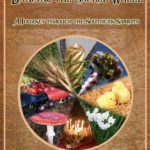I’ve lived in Australia for nearly a year and have spent much of this time getting to know the land and adjusting to the seasons in the Southern Hemisphere. Here in the Land Down Under, Samhain is still in autumn, but autumn is March to May; Halloween is still in October, which is in spring; the Winter Solstice is in July, but Christmas is in the summer; the Spring Equinox is in March, but Easter is still in April, which is autumn. If that sounds confusing, that’s because it is.
Weather patterns in Australia are different. It’s important to consider also that the four-season calendar was imported by the British in 1788. Indigenous Australians had their own seasonal calendars. Then there’s the Wiccan Wheel of the Year, which was founded upon the seasonal cycle of Great Britain.
Many books about the Pagan Wheel of the Year are written from a Northern Hemisphere perspective. Authors will sometimes acknowledge this and advise Southern Hemisphere readers to simply move the seasonal dates around six months, but this doesn’t always work well. Unfortunately, there aren’t too many books on the subject for Southern Hemisphere practitioners.
 In Dancing the Sacred Wheel: A Journey through the Southern Sabbats, long-time Wiccan Frances Billinghurst offers a thoughtful and well-researched consideration of the Wheel of the Year in the Southern Hemisphere. It’s clear that Billinghurst is wise, knowledgeable, and draws from many years of experience and experimenting with myth and ritual in Australia.
In Dancing the Sacred Wheel: A Journey through the Southern Sabbats, long-time Wiccan Frances Billinghurst offers a thoughtful and well-researched consideration of the Wheel of the Year in the Southern Hemisphere. It’s clear that Billinghurst is wise, knowledgeable, and draws from many years of experience and experimenting with myth and ritual in Australia.
Dancing the Sacred Wheel is not a book for the beginner Wiccan. It’s not a ritual book. It assumes a basic knowledge of the Wheel of the Year, its origins, and its underlying mythos. It challenges practitioners to reflect on what is happening in their local landscape and Billinghurst offers the results of her interpretation and adaptation.
Part I begins with three chapters that look at Paganism broadly, the Sabbats, and the common narrative of the God and Goddess that is played throughout them. Chapters 4-11 look at each Sabbat individually. Billinghurst looks at the meaning of each both in contexts of the Southern Hemisphere and our internal landscapes, offers ritual ideas, and even some recipes and local correspondences.
In Part II, Billinghurst reviews a basic circle casting, how to adapt learnings from the book, Aboriginal seasons, and delves further into Southern Hemisphere differences. For instance, in the Southern Hemisphere, the sun appears to travel from east to west along the north, not the south. So, deosil (sunwise) in the Southern Hemisphere is actually counter-clockwise.
Billinghurst is always kind and considerate in her book, never judgemental or preachy. It’s clear she knows her stuff, but she’s never dry or dull, and Dancing the Sacred Wheel is a very accessible book. She offers a lot of food for thought and can help smooth those rough edges of our seasonal rituals that don’t seem quite right sometimes when we’re attempting to adapt Northern Hemisphere practices.
Recently published just back in November 2012, Billinghurst’s book is a welcome and much needed resource the Southern Hemisphere’s Pagan’s library.

